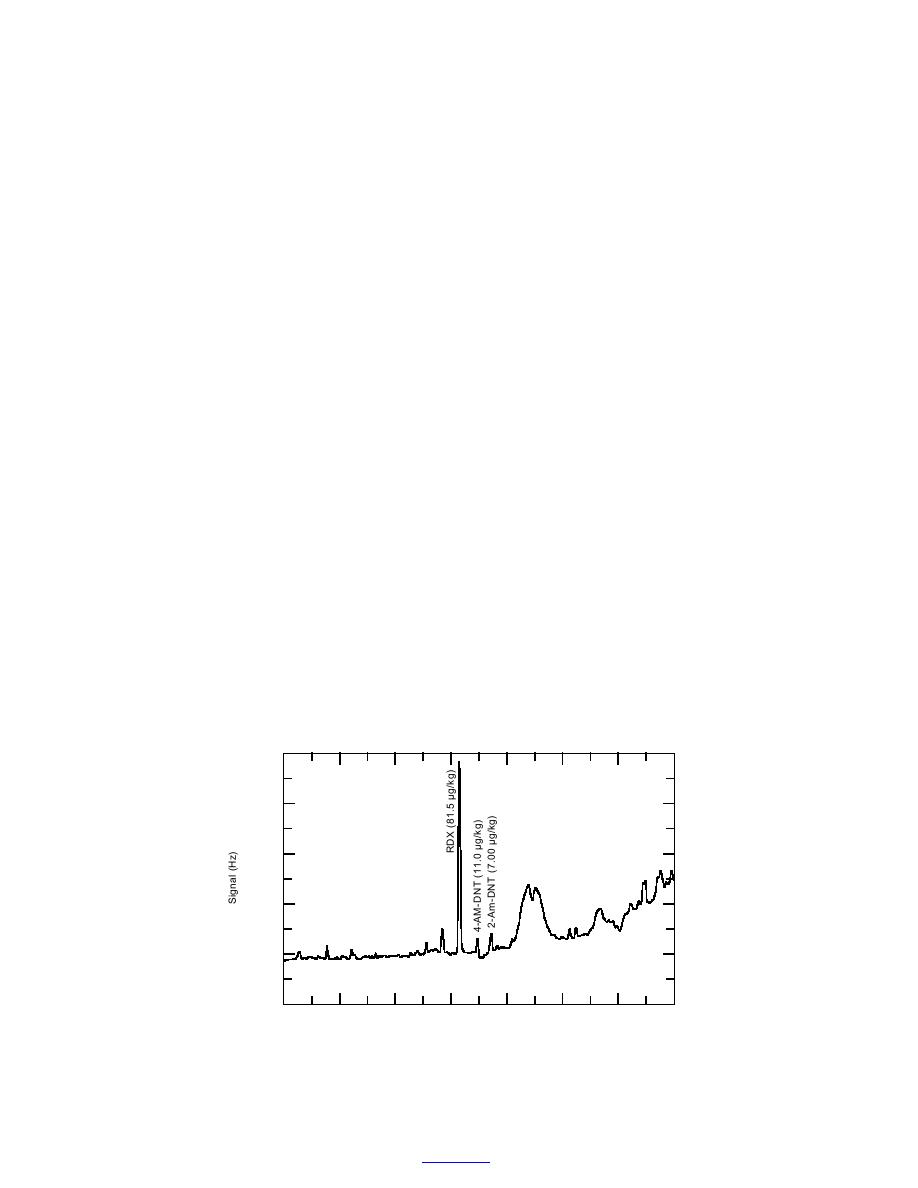
single round fired is probably quite small and perhaps
ples 6274). Analysis indicated that some very low
not detectable even using the low-level GC-ECD
levels of explosives-related residues were detectable in
method.
several of the samples associated with the crater as well
One surface sample was also collected about 400 m
as the samples collected 3 m distant. The highest con-
centration obtained was 42.5 g/kg for TNT in one of
to the east of the firing position, across the road from
the firing point and away from the direction of fire.
the 3-m samples. Otherwise, only 4-ADNT and 2-
Analysis of this sample indicated that 2,4-DNT was
ADNT were detected in a majority of samples, with
present at 33.5 g/kg. The source of this 2,4-DNT was
the highest concentrations being 12.1 and 7.3 g/kg,
apparently residue that was carried downwind from the
respectively.
firing activity.
The third area sampled was another 105-mm crater
(Table 8, samples 75 and 76). Two composite samples
Artillery range impact area
were collected within the crater and no explosives-
related analytes were detectable above 1 g/kg.
Analysis of soil samples collected within the artil-
lery range impact area is presented in Table 8. These
The fourth area sampled was another 105-mm crater,
samples were not collected randomly across the area,
thought to have been formed from the firing activity
but were associated with specific detonation events as
we observed by the National Guard the day before. Nine
determined by visual observation and discussions with
samples were collected near this crater; two composite
EOD technicians.
samples from within the crater and a seven-sample
The first area sampled was a crater that had been
wheel centered on the crater with the center sample
caused by the impact of a 105-mm artillery round within
taken from the bottom of the crater and the six others
a week of the time sampled. The type of munition that
collected around the rim of the crater (Table 8, samples
caused the crater was judged from the metal debris
7785). Several different explosives-related analytes
found within the crater and the age was estimated by
were detected in these samples, including RDX, TNT,
the visual presence of ash. At this location, nine sur-
2,4-DNT, 4-ADNT, and 2-ADNT. A chromatogram for
face soil samples were collected and analysis indicated
one of the composite samples taken from inside the
that no residues of explosives-related compounds were
crater is shown in Figure 17. RDX was found in each
present above a detection limit of about 1 g/kg (Table
sample at concentrations ranging from 16.0 to 93.4 g/
8, samples 4957).
kg. TNT was found in six of the nine samples at con-
centrations ranging from 1.2 to 21.0 g/kg. The two
The second area sampled was a crater that appeared
to have been formed by the detonation of a 120-mm
transformation products of TNT (4-ADNT and 2-
mortar, probably within two weeks of the date of sam-
ADNT) were each found in eight of the nine samples at
concentrations ranging from 5.4 to 20.6 g/kg and 2.6
pling. At this location, a total of 10 samples was col-
to 15.2 g/kg, respectively. 2,4-DNT was detected in only
lected in and around the crater and three samples were
two samples at concentrations of 7.3 and 9.9 g/kg.
collected about 3 m away from the crater (Table 8, sam-
5,000
RTX-5
Sample #78
4,000
3,000
2,000
1,000
0
3
17
5
7
9
11
13
15
Time (min.)
Figure 17. GC-ECD chromatogram of an extract from soil collected at a
crater from the detonation of a 105-mm howitzer round.
21
To contents



 Previous Page
Previous Page
